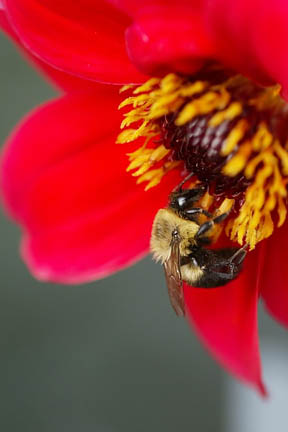02
May
Study Finds Neonicotinoids Cause Compound-Specific Harm to Bumblebees
(Beyond Pesticides, May 2, 2016) A study published online last week has examined the effects of three neonicotinoids (neonics) on bumblebee colonies, from live bee kills to changed sex ratios. Neonics have been widely cited as contributing to the demise of both managed and wild bee and pollinator populations. They can cause changes in bee reproduction, navigation, foraging, and even the suppression of bee immune systems.
 The study, published in Scientific Reports, looked at field-relevant levels (2.5 parts per billion) of imidacloprid, thiamethoxam, and clothianidin, and found compound-specific effects at all levels, including within individual bee cells, individual bees, and whole colonies in semi-field conditions. Given the limitations of laboratory studies and field studies, researchers conducted a semi-field study to try to recreate and represent real world exposure patterns. The neonics were provided to the bees as an optional supply of sugar syrup, but were free to forage and did need to gather pollen in order to grow and raise offspring. Researchers found that imidacloprid and clothianidin displayed abilities to affect neuronal Kenyon cells, which help with learning, memory and multisensory integration. At the whole colony level, thiamethoxam altered the sex ratio, leaving more males than females. Both imidacloprid and thiamethoxam caused deficits in colony strength. The researchers also found that clothianidin increased queen production, and speculated over the toxicity of clothianidin to bumblebees.
The study, published in Scientific Reports, looked at field-relevant levels (2.5 parts per billion) of imidacloprid, thiamethoxam, and clothianidin, and found compound-specific effects at all levels, including within individual bee cells, individual bees, and whole colonies in semi-field conditions. Given the limitations of laboratory studies and field studies, researchers conducted a semi-field study to try to recreate and represent real world exposure patterns. The neonics were provided to the bees as an optional supply of sugar syrup, but were free to forage and did need to gather pollen in order to grow and raise offspring. Researchers found that imidacloprid and clothianidin displayed abilities to affect neuronal Kenyon cells, which help with learning, memory and multisensory integration. At the whole colony level, thiamethoxam altered the sex ratio, leaving more males than females. Both imidacloprid and thiamethoxam caused deficits in colony strength. The researchers also found that clothianidin increased queen production, and speculated over the toxicity of clothianidin to bumblebees.
“There is clear evidence that imidacloprid and thiamethoxam are harmful to bees but our evidence raises a question over clothianidin,” said Christopher Connolly, Ph.D. to The Guardian. Dr. Connolly, with the University of Dundee, led the research. He continued, “I think there is sufficient evidence for a ban on imidacloprid and thiamethoxam, but not for clothianidin although the moratorium should continue,” as more evidence is gathered.
Only just over a year ago, another study coauthored by Dr. Connolly found that bumblebees exposed to field-relevant levels (2.1 parts per billion) of clothianidin suffered poor navigation and foraging skills. Clothianidin exhibited an acute effect on the bumblebee’s brain, breaking down the mitochondria in its brain cells. At the time, Dr. Connolly stated, “Our research demonstrates beyond doubt that the level of neonicotinoids generally accepted as the average level present in the wild causes brain dysfunction and colonies to perform poorly when consumed by bumblebees.”
While this serves as an example that science is continually searching for answers, there is an overwhelming amount of research demonstrating that neonicotinoids, such as imidacloprid, thiamethoxam and clothianidin working individually or synergistically, play a critical role in the ongoing decline of bees and other pollinators. Neonicotinoids affect the central nervous system of insects, resulting in paralysis and eventual death. These pesticides have consistently been implicated as a key contributor in pollinator declines, not only through immediate bee deaths, but also through sublethal exposure that causes changes in bee reproduction, navigation, and foraging. Pesticide exposure can impair both detoxification mechanisms and immune responses, rendering bees more susceptible to viruses, parasites, and other diseases, and leading to devastating bee losses.
In another study, Seed coating with a neonicotinoid insecticide negatively affects wild bees, Swedish scientists reported that wild bees and bumblebees foraging in crops treated with a commonly used insecticide seed coating, a combination of the neonicotinoid clothianidin and the non-systemic pyrethroid β-cyfluthrin, are less likely to reproduce when compared to bees in untreated fields, and that bumblebee colonies in treated fields gain less weight. Additionally, fewer wild bees and bumblebees are found in treated fields than in untreated ones.
For these reasons and many others, Beyond Pesticides works to promote the widespread transition of conventional farmland to organic production. Organic law requires farmers to foster soil health, and create a strategy to deal with pest populations before they become a problem. Because of these factors, many organic farms do not require the use of even organic-compatible pesticides, opting instead to increase pest and disease resiliency through an increased diversity of pest predators.
With one in three bites of food reliant on bees and other insects for pollination, the decline in bees and other pollinators due to pesticides, and other man-made causes demands immediate action. For more on this and what you can do to protect pollinators, visit Beyond Pesticides’ BEE Protective webpage.
Source: The Guardian
All unattributed positions and opinions in this piece are those of Beyond Pesticides.










